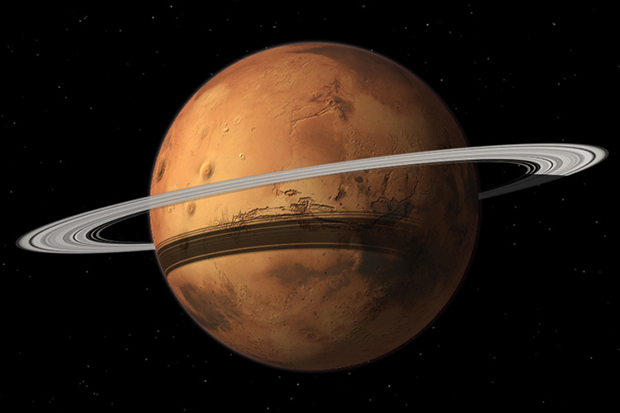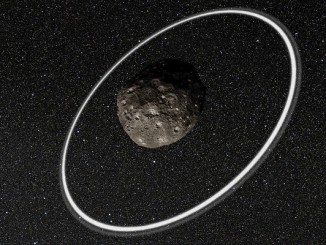
The red planet Mars is destined to become the ringed planet within 40 million years’ time, when its largest moon Phobos is torn apart, according to two scientists from the University of California, Berkeley.
Potato-shaped Phobos, which is 27 kilometres across at its widest point, is gradually spiralling closer to Mars by a few centimetres every year. As it tumbles around Mars, the planet’s gravity tugs unevenly on the body of Phobos, which is thought to be a captured asteroid filled with fractures and cavities and which is not as sturdily held together as Earth’s Moon, for example.
While it has been known for some time that Phobos’ lifespan is limited, it had been uncertain whether it would crash into Mars or break apart before that could happen. Now Berkeley’s Benjamin Black and Tushar Mittal, writing in the journal Nature Geoscience, have determined that Phobos will be torn apart by the uneven gravitational tides from Mars, forming a ring that could last up to a hundred million years.
“If [Phobos] broke apart at 1.2 Mars radii, or 680 kilometres above the surface, it would form a really narrow ring comparable in density to one of Saturn’s most massive rings,” says Mittal. This ring would last for a few million years before gradually widening to the point that debris would begin reaching the top of Mars’ atmosphere, resulting in stunning meteor showers while larger chunks of debris would spiral inwards and impact the surface at a shallow-angle, carving out elliptical-shaped craters on the surface. Alternatively, if Phobos broke up further out, the ring would be much longer-lived.

To determine that Phobos would succumb to Mars’ gravitational forces, Black and Mittal looked at the structural strength of similarly fractured rocks to Phobos that are found on Earth, as well as meteorites that sport a similar density and composition to Mars’ moon. They were also able to draw conclusions about what kind of force the moon could withstand by simulating the massive impact that created Phobos’ ten-kilometre wide crater, Stickney.
Intriguingly, this ring-building scenario may have played itself out numerous times before in the Solar System’s history. The rings of the outer planets, including Saturn’s, are thought to have formed from icy moons that were torn apart by gravity. There are also many elliptical craters on Mars’ surface, suggesting chunks of torn up moons may have fallen from previous rings around the red planet before.
Unfortunately, any ring is unlikely to look as spectacular as Saturn’s rings, which are formed from icy particles that strongly reflect light. Instead, Phobos is likely to leave a dark and dusty ring, although it would increase Mars’ overall brightness somewhat and possibly cast shadows on the surface.
“Standing on the surface of Mars a few tens of millions of years from now, it would be pretty spectacular to watch,” says Black.



